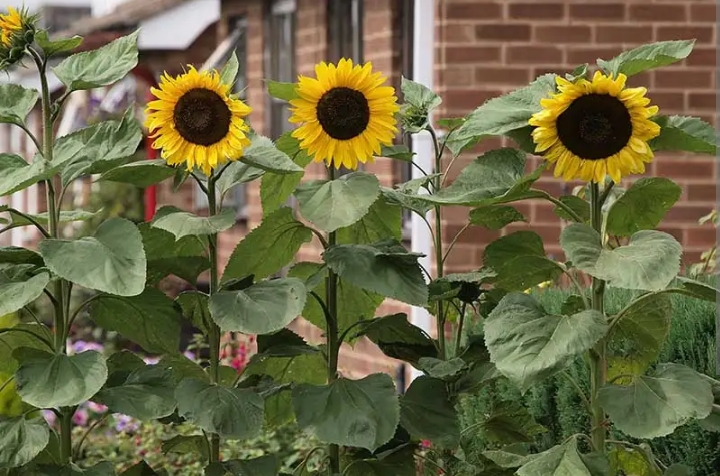Overview
Sunflowers are part of the Asteraceae family, which is the second largest plant family and contains over 16 000 different species. Sunflowers are the only major crop that originated solely in North America most likely in the Central United States.
The plant has large, broad lower leaves which are oval and arranged alternately on the stem and smaller, narrower upper leaves which are attached individually to the stem. The flower head is a large disc made up of yellow-golden florets. The outer florets are sterile and produce the outer petals of the flower head, while the inner florets will mature into the seeds in the central disc.
Sunflowers are annual plants, harvested after one growing season and range from 3-15 feet in height. There are many varieties of sunflower which can be used for cut flowers, garden subjects, animal food, bird seeds, oil, flour and for human food as snacks and in baked goods and salads. Many commercial cultivars are single-headed, with one bloom per plant. Wild sunflowers and many of the cut flower and multicolored garden cultivars are multi-branching with many blooms per plant.
Major Parts of Sunflower Plant
Leaves
Common sunflower leaves are arranged alternately along the stem except for new leaves at the base of the plant, which are arranged opposite. Leaves are simple, have serrated margins and are triangular to heart-shaped in outline. Leaves are 4 top 12 inches in length and have hairs on both surfaces. The leaves can make a tea and used to control fever or made into a poultice to treat snakebites or insect bites.
Stem/Stalk
Stems are stiff and erect ranging from 3 to 12 feet tall, often purplish with green specks, hairy and branching towards the upper half of the plant, displaying the flowers in a horizontal line or gentle arch. The stem supports the plant and the leaves, transports water and nutrients from the roots around the plant. Sunflower stem is fibrous and tough and can be used for making ropes or as fuel.
Seeds
Sunflower seeds come from the large flower heads. Sunflower seeds are actually individual one-seed fruits called ‘’achenes’’ formed from the inferior ovaries of the disk florets. The seeds have a mild, nutty flavor and firm but tender texture. The seeds may be eaten dried, roasted or ground into nut butter and are common in birdseed mixes.
Sunflower Head
The flower head is a large disc reaching 12-36 cm (4-12 inches) in diameter which is made up of 16-30 individual golden-yellow florets arranged in an intricate pattern. The florets are generally classified into two types: Disk florets and ray florets. Ray florets are flowers with long, straplike petals along the outside of the sunflower. Each petal on the outside of a sunflower is a flower. Disc florets are the flowers tightly clustered together inside the ray florets. The ray florets are unable to reproduce by themselves because they are missing one or more sex organs. The disc florets posses both male and female reproductive organs. These yellow, petal-like flowers exhibit an elongated petal shape, are characterized by bilateral symmetry, and are generally sterile.
Roots
In sunflower, there is a main root and several secondary roots. They are usually strong and quite fibrous. The main root also referred to as taproot is capable of reaching a depth of up to one meter below the surface whereas the secondary roots also referred to as lateral roots shoot out horizontally from the top of the taproot. Roots support the plant and help secure it in the ground so that it does not fall over as it grows. Roots are like straws and absorb all the water and nutrients from the soil which the plant needs to live.
Growing Sunflower Plants

Sunflowers are annual plants that grow virtually anywhere. Seeds are sown after frost danger is over. Sunflowers are tolerant of most soils, but do best in well-draining, rich garden soil with organic material added. They need at least six hours of direct sun daily. Plant seeds in 4-inch-deep furrows, spacing them 6 inches apart and covering them with 1/2 inch of soil. For large cultivars, thin plants to 1 1/2 to 2 feet apart and fill the furrow as seedlings grow to help support the tall stalk. Stake tall stems to support the heavy developing seedhead. Provide water during dry spells. Harvest seeds when the flower heads are dry, or leave seeds in place for birds to harvest.